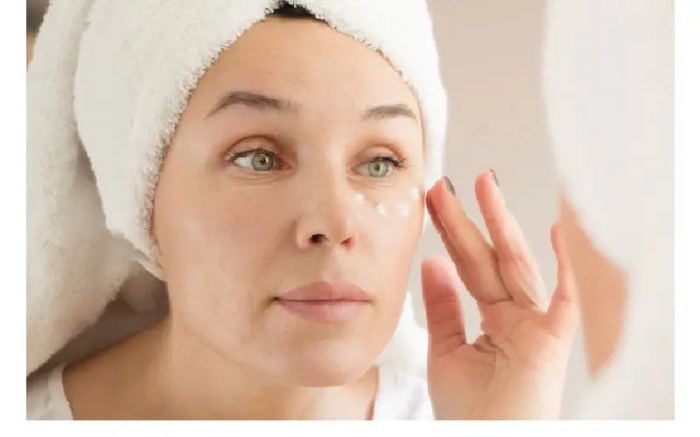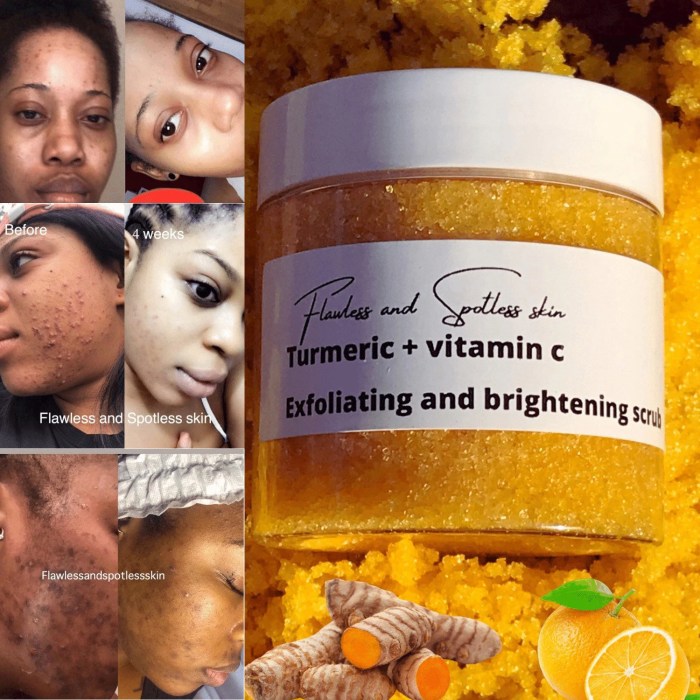DIY dark spot remover offers a natural approach to tackling those pesky blemishes that can mar an otherwise flawless complexion. Whether you’re dealing with sun damage, acne scars, or hormonal fluctuations, these home remedies harness the power of readily available ingredients to brighten and even skin tone.
Table of Contents
This guide delves into the science behind these DIY solutions, exploring common ingredients like lemon juice, turmeric, and yogurt. You’ll discover effective recipes tailored to various skin types, learn application techniques, and understand the importance of consistency and patience. While these natural remedies can be effective, it’s crucial to prioritize safety by conducting patch tests and consulting a dermatologist if any adverse reactions occur.
Understanding Dark Spots: Diy Dark Spot Remover
Dark spots, also known as hyperpigmentation, are areas of skin that appear darker than the surrounding skin. They can occur on any part of the body, but are most common on the face, neck, and hands. While they are generally harmless, dark spots can be a source of cosmetic concern for many individuals.
Causes of Dark Spots
Dark spots are caused by an overproduction of melanin, the pigment that gives skin its color. This overproduction can be triggered by a variety of factors, including:
- Sun Damage: Excessive sun exposure is the most common cause of dark spots. The ultraviolet (UV) rays from the sun stimulate melanin production, leading to hyperpigmentation. This is why it’s crucial to wear sunscreen daily and avoid prolonged sun exposure, especially during peak hours.
- Acne Scars: When acne lesions heal, they can sometimes leave behind dark marks called post-inflammatory hyperpigmentation (PIH). This occurs when the body produces excess melanin in response to inflammation.
- Hormonal Changes: Hormonal fluctuations, such as those that occur during pregnancy or with certain medications, can also trigger hyperpigmentation. This type of dark spot is often referred to as melasma.
- Other Factors: Other factors that can contribute to dark spots include genetics, certain skin conditions like eczema, and even some medications.
Types of Dark Spots
Dark spots can be categorized into different types, each with its own characteristics and causes:
- Melasma: This type of hyperpigmentation is often triggered by hormonal changes, especially during pregnancy. It appears as brown or grayish patches, typically on the face, particularly the cheeks, forehead, and upper lip.
- Freckles: These are small, flat, brown spots that are often concentrated on areas of the skin exposed to the sun. Freckles are caused by a cluster of melanocytes, the cells that produce melanin, in a small area.
- Post-Inflammatory Hyperpigmentation (PIH): This type of hyperpigmentation is a result of inflammation, often from acne, burns, or other skin injuries. It appears as dark spots that can range in color from brown to black.
Formation of Dark Spots
Dark spots form when melanocytes, the pigment-producing cells in the skin, produce an excess of melanin. This excess melanin accumulates in the skin, creating the darker appearance. The exact mechanism of melanin overproduction varies depending on the cause of the dark spot.
For example, sun exposure triggers the production of melanin as a protective mechanism against UV damage. However, this can lead to hyperpigmentation if the sun exposure is excessive or prolonged.
Popular DIY Dark Spot Remover Recipes

There are numerous DIY dark spot remover recipes available online and in beauty communities. These recipes often use natural ingredients believed to have skin-lightening properties. While some of these remedies might offer mild benefits, it’s crucial to remember that they haven’t been scientifically proven to be effective for everyone and may not work as well as commercially available products. Additionally, some ingredients can cause irritation or allergic reactions, so it’s always recommended to perform a patch test before applying any DIY recipe to your entire face.
DIY Dark Spot Remover Recipes
Here is a table showcasing various DIY dark spot remover recipes, their ingredients, and potential benefits:
| Recipe Name | Ingredients | Benefits | Notes |
|---|---|---|---|
| Lemon Juice and Honey Mask |
|
|
|
| Yogurt and Turmeric Mask |
|
|
|
| Aloe Vera and Sandalwood Paste |
|
|
|
DIY Dark Spot Remover Techniques
Applying DIY dark spot removers involves various techniques, each catering to specific needs and preferences. Understanding these techniques is crucial for maximizing the effectiveness of your chosen remedy.
Direct Application
Direct application is the simplest method, involving directly applying the DIY dark spot remover to the affected area. This technique is suitable for smaller, isolated dark spots. For instance, you can use a cotton swab or your fingertips to apply a lemon juice and honey mixture directly to a freckle.
Masking
Masking is an effective technique for covering larger areas of hyperpigmentation. It involves applying a thin layer of the DIY dark spot remover to the affected area and covering it with a breathable material like a gauze pad or a thin cloth. This method allows the remover to penetrate deeper into the skin while preventing it from drying out too quickly. For example, you can apply a turmeric paste to your forehead and cover it with a gauze pad for 15-20 minutes.
Spot Treatment
Spot treatment involves focusing on specific dark spots, targeting them with concentrated DIY remedies. This technique is ideal for treating stubborn dark spots that require a more intense approach. You can use a cotton swab to apply a mixture of baking soda and lemon juice to a dark spot, leaving it on for a few minutes before rinsing.
Consistency and Patience
Regardless of the technique chosen, consistency and patience are crucial for achieving noticeable results. DIY dark spot removers often require regular application over a prolonged period to effectively reduce hyperpigmentation.
Storing and Using DIY Dark Spot Removers Safely
Proper storage and usage are essential for maximizing the effectiveness and safety of your DIY dark spot removers.
- Store your DIY remedies in airtight containers, away from direct sunlight and heat, to preserve their potency and prevent spoilage.
- Always perform a patch test on a small area of skin before applying any DIY remedy to your entire face or body. This helps identify potential allergic reactions.
- Limit the application time of DIY remedies to avoid irritation or skin damage.
- Do not use DIY dark spot removers on open wounds or broken skin.
- If you experience any adverse reactions, discontinue use and consult a dermatologist.
DIY Dark Spot Remover for Different Skin Types

It’s essential to choose DIY dark spot remover recipes that cater to your unique skin type. This ensures you get the most effective results while minimizing the risk of irritation or further skin issues.
DIY Dark Spot Remover Recipes for Different Skin Types
| Skin Type | Recipe Name | Ingredients | Instructions |
|---|---|---|---|
| Oily Skin | Lemon and Honey Mask |
|
|
| Dry Skin | Yogurt and Turmeric Mask |
|
|
| Sensitive Skin | Aloe Vera and Rosewater Mask |
|
|
Tips for Adapting DIY Dark Spot Remover Recipes
- Patch Test: Always perform a patch test on a small area of your skin before applying any new DIY recipe to your entire face. This helps prevent allergic reactions.
- Frequency: Start with applying the DIY dark spot remover 2-3 times a week. If your skin tolerates it well, you can gradually increase the frequency.
- Sun Protection: Always apply sunscreen with an SPF of 30 or higher after using any DIY dark spot remover, as these ingredients can make your skin more sensitive to the sun.
- Consistency: Patience is key when using DIY remedies. Be consistent with your application, and you’ll start to see results over time.
- Consult a Dermatologist: If you have persistent or severe dark spots, it’s always best to consult a dermatologist for personalized advice and treatment options.
Combining DIY Dark Spot Remover with Other Treatments

Boosting the effectiveness of DIY dark spot removers is all about creating a synergistic approach that addresses multiple skin concerns. Combining these treatments with other skin care practices can amplify their results and promote overall skin health.
Incorporating DIY Dark Spot Remover into a Comprehensive Skin Care Routine
A well-rounded skincare routine can greatly enhance the efficacy of DIY dark spot removers. Here’s how you can integrate them:
- Exfoliation: Regular exfoliation removes dead skin cells, allowing the active ingredients in your DIY dark spot remover to penetrate deeper and work more effectively. Gentle exfoliation with a scrub or chemical exfoliant like glycolic acid can be done 1-2 times a week.
- Moisturization: Hydration is crucial for healthy skin and helps maintain the skin’s barrier function. Using a moisturizer after applying your DIY dark spot remover can help lock in moisture and prevent dryness, which can sometimes be a side effect of certain ingredients.
- Sunscreen Use: Protecting your skin from the sun’s harmful UV rays is essential, especially when using DIY dark spot removers. UV exposure can darken existing spots and even cause new ones to form. Apply a broad-spectrum sunscreen with an SPF of 30 or higher daily, even on cloudy days.
Tips for Maximizing the Effectiveness of DIY Dark Spot Removers
Here are some valuable tips to maximize the effectiveness of your DIY dark spot removers:
- Consistency is Key: Be patient and consistent with your DIY dark spot remover routine. Results may take several weeks or even months to become noticeable.
- Patch Test: Before applying any DIY dark spot remover to your entire face, perform a patch test on a small area of skin to check for any allergic reactions or irritation.
- Choose the Right Ingredients: Select ingredients that are appropriate for your skin type and concerns. For example, if you have sensitive skin, opt for gentle and natural ingredients.
- Storage: Properly store your DIY dark spot remover to maintain its effectiveness. Keep it in a cool, dark place, away from direct sunlight and heat.
- Limit Sun Exposure: While sunscreen is essential, reducing direct sun exposure can further prevent the formation of new dark spots and help fade existing ones.
Embarking on a DIY dark spot removal journey requires a blend of knowledge, patience, and a touch of experimentation. By understanding the causes of hyperpigmentation, choosing the right ingredients for your skin type, and incorporating these natural remedies into a comprehensive skincare routine, you can gradually achieve a brighter, more even complexion. Remember, consistency is key, and while results may not be immediate, the rewards of a radiant, confident glow are well worth the effort.
DIY dark spot removers can be a great way to tackle hyperpigmentation, but finding the right ingredients and method can be a challenge. If you’re looking for a more targeted approach, you might consider exploring options like semaglutide, which has shown promise in reducing weight and improving skin health. You can find more information on the semaglutide cost and potential benefits online, but remember to consult with a healthcare professional before making any decisions about your treatment plan.
Ultimately, the best approach for your dark spots will depend on your individual needs and skin type.

